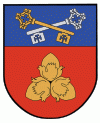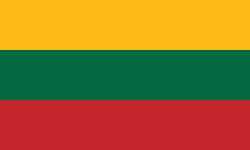Šalčininkai
 |
The name of the city derives from Šalčia river, than means in Lithuanian language šalta – cold (waters, river). The region around Šalčininkai was inhabited by Lithuanians and it is one of the centres where forefathers of written Lithuanian language were born (including Stanislovas Rapalionis, Jurgis Zablockis and Aleksandras Rodūnonis), but during the course of history, the demographics changed and now in the environs of Šalčininkai, uncodified Belarusian vernacular (called po prostu by the locals) is widespread and the city itself is considered the most important provincial centre of Polish culture in Lithuania (the urban centre being Vilnius).
Šalčininkai attained the town status in 1956 and is now a capital of the Šalčininkai district municipality. According to the latest census of 2021, Šalčininkai had 6857 inhabitants and features a multi-ethnic population of 4930 Poles (71.9%), 920 Lithuanians (15.7%), 438 Russians (6.4%), 286 Belarusians (4.2%), 61 Ukrainians (0,9%) and 222 people of other background (3.2%). 12.2% of all inhabitants in Šalčininkai district municipality, according to the 2021 census were born abroad, while 87.8% were born in Lithuania. This was a decrease from 14.3%, recorded by the previous – 2011 census. Out of 34.5 thousand inhabitants in 2011, 3711 or 10.7% of all the inhabitants were born in Belarus, 728 or 2.1% in Russia. Šalčininkai contains the highest percentage number of Poles of any town in Lithuania. The town's coat of arms, designed by Arvydas Každailis, shows three hazelnuts symbolizing solidarity of the population.
* Władysław Kozakiewicz (born 1950), Polish pole vaulter and Olympic champion
* Henoch Leibowitz
* Aaron Soltz
Map - Šalčininkai
Map
Country - Lithuanian_Soviet_Socialist_Republic_(1918–1919)
 |
 |
| Flag of Lithuania | |
Germany had lost World War I and signed the Compiègne Armistice on 11 November 1918. Its military forces then started retreating from the former Ober Ost territories. Two days later, the government of the Soviet Russia renounced the Treaty of Brest-Litovsk, which had assured Lithuania's independence. Soviet forces then launched a westward offensive against Estonia, Latvia, Lithuania, Poland and Ukraine in an effort to spread the global proletarian revolution and replace national independence movements with Soviet republics. Their forces followed retreating German troops and reached Lithuania by the end of December 1918.
Currency / Language
| ISO | Currency | Symbol | Significant figures |
|---|---|---|---|
| EUR | Euro | € | 2 |
| ISO | Language |
|---|---|
| LT | Lithuanian language |
| PL | Polish language |
| RU | Russian language |















